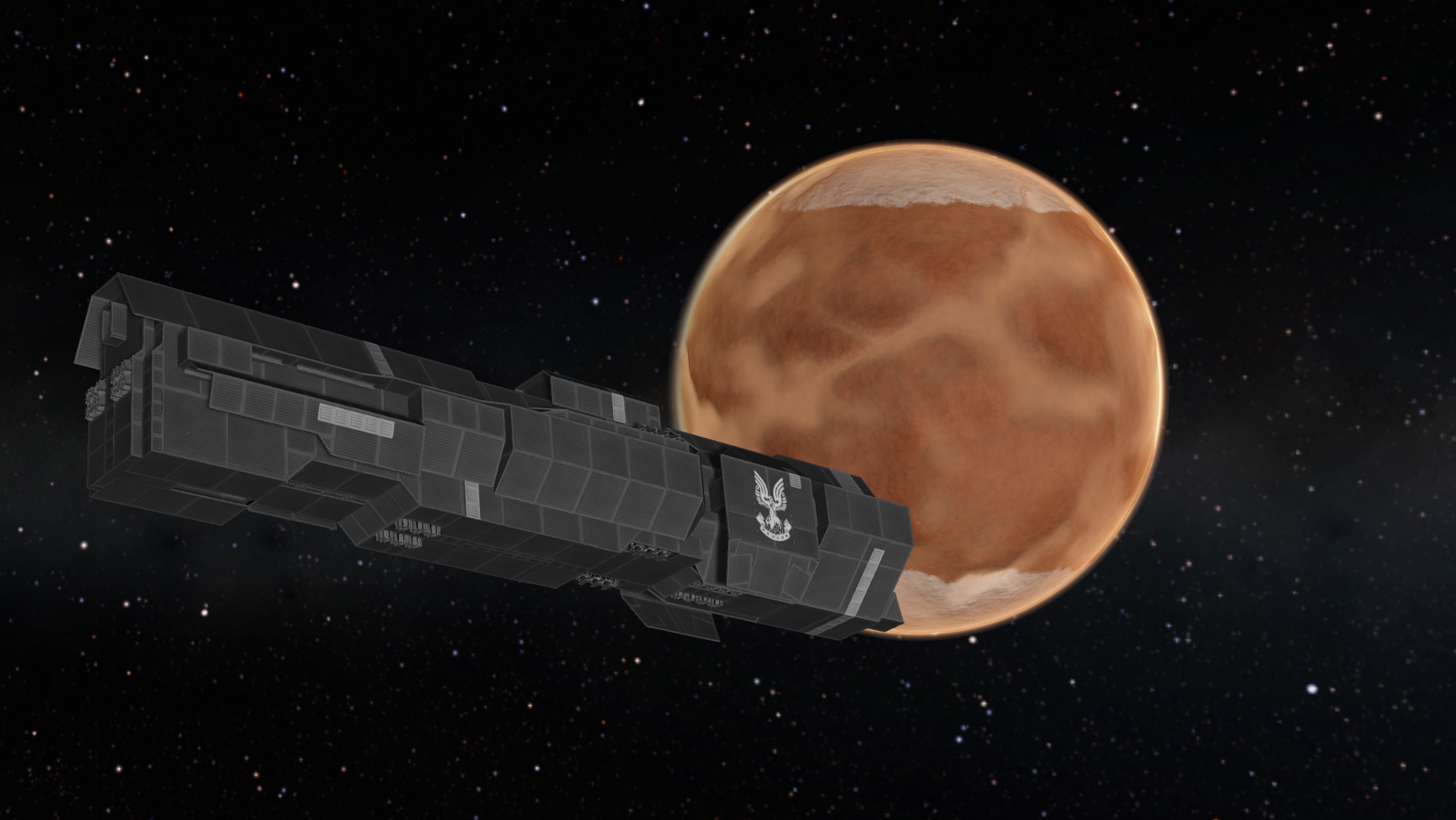Trinity Class Heavy Carrier
The Trinity-Class Heavy Carrier is a Black-Water Heavy Carrier in use with the Atreus Aerospace Command, and the Confederacy of Veiid.
|
Trinity Class
Trinity-Class Heavy Carrier
|
|||||
|---|---|---|---|---|---|
| Heavy Carrier | |||||
 |
|||||
| AASC Hell or Highwater (CV-06) during a maneuver around Duna. c. 2197 | |||||
| National Origin | Confederacy of Atreus | ||||
| Production History | |||||
| Designed | |||||
| 2193 - 2195 | |||||
| Produced | |||||
| 2195 - 2196 | |||||
| Designer | Odyssey Aerospace Astronautical Design Office | ||||
| Unit Cost | 172,805(√) | ||||
| Number Built | 2 | ||||
| Service History | |||||
| In Service | |||||
| 2196 - N/A | |||||
| Used By | Confederacy of Atreus | ||||
| Spacecraft Characteristics | |||||
| Launch Mass | 310,300 kg | ||||
| Dry Mass | 160,700 kg | ||||
| Length | 38.0 m | ||||
| Width | 7.6 m | ||||
| Height | 8.5 m | ||||
| Propulsion | 2 RE-M3 "Mainsail" Chemical Rockets 6 RE-J10 "Wolfhound" Chemical Rockets | ||||
| Maximum Thrust | 5250 kN | ||||
| Specific Impulse | 337 seconds (2171 m/s) | ||||
| Complement | 65 total, 15 officers, 10 Senior NCOs, 40 Enlisted Personnel | ||||
| Armament | Mark IV Heavy Magnetic Accelerator Cannon 36 Small/Medium Missile Cells | ||||
| Spacecraft Carried | 10 Multirole Fighters | ||||
Design
The Trinity-Class Heavy Carrier is a staple of the Atreus Aerospace Command (AASC), being highly versatile and flexible in both role and mission.
The Trinity-Class is defined by her long, continuous shape, with a prominent bow containing eight missile cells as well as her single Mark IV Heavy Magnetic Accelerator Cannon, which runs a portion of the ship.
The majority of the Trinity's internal space is taken up by various flight facilities, including hangar bay doors and docking areas for small fighters, which are very tightly packed inside of her hull.
Similar to Odyssey's future project in the Hartfordia II-Class Heavy Cruiser, the Trinity uses a massive amount of engines to achieve a Thrust-to-Weight ration unseen outside of the AASC, giving the Trinity maneuverability similar to a light cruiser rather than a heavy carrier.
Development
With the majority of Sub-capital contracts and hulls completed and delivered to the AASC by 2195, the AASC began looking to build a new Heavy Carrier/Fleet Carrier to serve as the largest of their ships and Flagships for their Admirals.
With the Siren-Class Escort Carrier entering service shortly after initial requirements went out for the Next Generation Flagship Program (NGFS), the AASC Navy Warfare Development Command (NAVWARDEV) quickly outlined flaws in focusing on a single Heavy Carrier hull, and decided to split the NGFS Program into a Next Generation Heavy Carrier (NGCV) and Next Generation Fleet Carrier (NGCVB) Programs, with the NGCVB program leading to the development of the Retribution-Class Fleet Carrier.
Awarding the contract for the NGCV to Odyssey Aerospace Astronautical Design Office, the Trinity Class was one of the first ships to be fitted with the still experimental Mark IV Heavy Magnetic Accelerator Cannon.
However, concerns were raised due to the relatively limited hangar space and logistical capacity offered by a Fleet Carrier on the smaller side. However, with the adoption of the Retribution-Class, these concerns were addressed by the size of the Fleet Carrier.
Flight Deck
The Hangar of the Trinity-Class is multi-layered, being unique in that aspect. The hangar bay doors are located at the bottom of the hull of the carrier, being split in two areas by a partition in the middle making flight operations highly vertical, being performed by deck crews using EVA "Jetpacks" to maneuver quickly.
However, this makes flight operations impossible while under any movement impossible, also exposing Trinity-Class Carriers to attacks while conducting operations as making any evasive maneuvers would bring serious injury or death to any deck crew operating using EVA packs as the ship would rapidly accelerate compared to them, crushing them against the hull and high speeds.